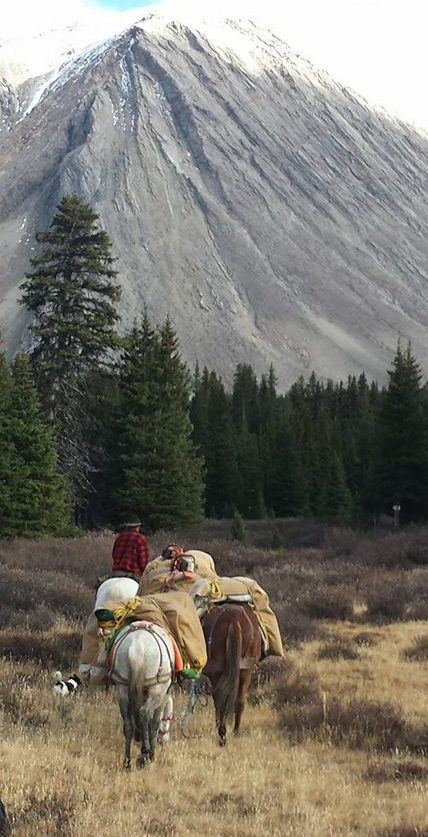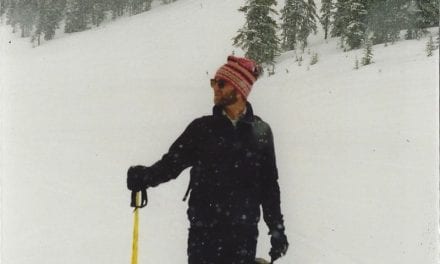This Oral History interview was funded in part by a research grant received in 2021 from the Government of Alberta through the Alberta Historical Resources Foundation.
Thank you to the Whyte Museum of the Canadian Rockies for granting permission to the Park Warden Service Alumni to post this interview on our website.
Park Warden Service Alumni Society of Alberta
Oral History Project Phase 11 – Autumn 2021
In Person Interview with Paul Peyto
November 12, 2021 – 10:00 am
Invermere, BC
Interviewed by Susan Hairsine
SH: What was the place and date of your birth?
Paul: Downtown Banff. January 11, 1947.
SH: Where did you grow up?
Paul: Banff, and in the bush around Banff.

SH: Why did you want to join Parks Canada?
Paul: I wanted to join the Warden Service because at the time, the park still had the districts and stuff, and I thought that would be a helluva good way to live. I started out as a seasonal which was probably the best gig I had with the Warden Service, as a seasonal. We got to do everything then. When I did get on steady it was right when they started centralizing everybody and putting guys that wanted to be in the bush on the road, and putting guys that wanted to be on the road in the bush.
SH: Who would have been the Chief Warden in those days?
Paul: Bob Hand was Chief Warden when I started. He was there quite a long time. Bert Pittaway too.
SH: How did you become involved in the Warden Service? Which national park did you start working in?
Paul: I could say my grandfather told me but he didn’t really. He was part of it to start with for sure. I started working for Squint, Art Cartlidge, on fire road crews and all that stuff… driving truck. He’d teach us how to run a grub hoe every now and then on trails.
SH: So were you building the fire roads?
Paul: Well maintaining them and stuff. They had their own crews and stuff. Equipment building and that was where we worked out of. It was alright.
SH: So that was in Banff where you were working?
Paul: Ya. At that time when I was working for Squint, everybody called him Squint.
SH: So Squint is Art Cartlidge?
Paul: Yes, he was in charge of all the Warden Service maintenance crews, roads crews and stuff. Fire roads up the Spray and Cascade, and the one up the Alexandra River too. At that time all the warden stations were manned in the winter time, so we’d go up the Spray and Cascade as far as Windy.
SH: When you were in the Warden Service did you ever live in any of those stations in the winter?
Paul: No, not up there.
SH: So you were all over Banff where the fire roads were.
Paul: Yes, but that was when I was working for Squint.

Paul wearing half of a park warden’s uniform. Photo courtesy of Jane Gilmar
SH: Do you have any idea when that would have been.
Paul: In 1966. The warden station was right where the first part of the Lake Louise Inn is now.
SH: So you worked for him before you started with the Warden Service?
Paul: Ya. I started as a seasonal in Lake Louise.
SH: So as a seasonal warden you were a backcountry guy?
Paul: Lake Louise was a district then. We had the first ten miles of the Pipestone. As soon as you got out of the bush, clearing that trail, you had to go back into the bush and down to town. That was mostly road stuff but lots of trail work and stuff. We’d pick up gibbled people on the trails.
SH: Were the people who were injured on the trails mostly horse people?
Paul: No hikers, climbers.
SH: So you dealt with climbers?
Paul: Oh man, we got involved in all that shit too. That was a good thing. We were involved with mountain rescue stuff, highway accidents, looking for people who were lost, driving down the road with your neck tie on so some ping ponger could take a picture of you.
SH: Okay, so when you were doing mountain rescue were you already a climber, or how did that work in those days?
Paul: It was part of the job. Walter Perren would come and take us out and tell Jay Morton, “Stand up Jay, you won’t bump zee head.”
SH: So he’d take you guys out and teach you to climb. You also had some first aid training?
Paul: Just the basic stuff. Ed Carleton said, “Them climbers, they all fit in the same plastic bag.”
SH: What different parks did you work in? How did they compare? Do you have a favorite?
Paul: I was mostly in Banff. I was in Jasper for a bit and got on there and thought that’d be okay. Lots of backcountry there. I went there and ended up getting posted in town. That was back in the hippy days. Mike Schintz and I, our main claim to fame was kicking hippies off the administration (grounds) lawn. We seemed to be doing a lot of that.
SH: So that would have been when?
Paul: I don’t know, early ‘70s.
SH: So you worked frontcountry in Jasper and went back to Banff after that? Paul: Yes.

Paul packing into the Skoki area towards Fossil Mountain
SH: What were some of your main responsibilities over the years?
Paul: Well we seemed to be doing everything. Back then, the climbers all got signed out. They used to have to come to the Warden Station and get signed out, and then check back in. We were doing fire work, trail clearing, traffic accidents, whatever.
SH: Did you have to do some wildlife stuff as well?
Paul: Ya, some wildlife stuff. It was right when bear tranquilizing was just getting started. It was kind of a hit and miss free-for-all kind of deal. Jim Robertson was the head wildlife guy as far as the tranquilizing goes. That was good entertainment.
SH: So there were bears in the dump then as well.
Paul: Yes but there were no big problems. Bears were bears and they were part of the park. There was the odd one. I can tell you some stories.
(Larry) Gilmar and I we were working at Saskatchewan Crossing then. We had this fairly good sized black bear. The dump was open past the resort. The garbage dump was between there and Rampart Creek. We had this good sized black bear that was causing quite a bit of shit. So we were trying to get him. We had the trap set up at Rampart, because he was in there lots. But our pickup truck had to go to Banff to the garage. It was in there for a few days. So they gave us the old four-panel van that they used to use for hauling people from Norquay, from the ski hill down to the hospital in the wintertime. It was one of those where the doors would open from the centre to the side. That was our limo. So we were touring around and we’d been up in the evening checking this thing. Gilmar is driving and we’re heading back to the crossing. No bear. We had the tranquilizing stuff in the van. We were probably five miles from Rampart Creek and this bear comes sashaying out of the bush up near Mount Wilson. Larry says “Jesus Christ, look at that”. And I said “Ya, that’s him.” So Larry says “Now what are we going to do?” So I said, “Let’s tranquilize the son of a bitch”. And Larry says, “Then what?” So I said we could skid him into the back of this thing and run him up to the trap.” Larry says, “You crazy son of a bitch!” So we go and tranquilize this bear. Got the panel van down in the ditch. Put a rope around the bear so we could skid him up into the back of this panel van. We couldn’t get the doors shut, because he was still hanging out a bit of the back…. He was a good sized bear. So we tied the two door handles with a piece of rope so they’re not completely closed. We get in the van to get going and Larry says “I don’t know if I should drive fast so we get there or drive slow so I can get the hell out of here if he comes around.”
So we go driving into Rampart Creek, and there’s people camping there. The trap is sitting by a picnic shelter part way in there. So we back up to bear trap. People are looking at us, because you can see a foot hanging out the back of the door of the van. We run a rope up to the inspection hole at the front of the trap. We get the van right up to the back of the trap and one guy is heaving and pulling on the rope in the front of the thing, and we finally got the bear in the trap, and he’s half coming out of the ether, but we hooked up to it and away we went. People looking at us wondering if we should get our heads read or not.
SH: It’s amazing before the days of iPhones what you could get away with.
Paul: Oh ya, that’s when you could have fun.
SH: What a great story. (Tape 15:11)



